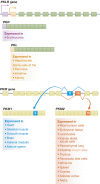PKM2, cancer metabolism, and the road ahead
- PMID: 27856534
- PMCID: PMC5283597
- DOI: 10.15252/embr.201643300
PKM2, cancer metabolism, and the road ahead
Abstract
A major metabolic aberration associated with cancer is a change in glucose metabolism. Isoform selection of the glycolytic enzyme pyruvate kinase has been implicated in the metabolic phenotype of cancer cells, and specific pyruvate kinase isoforms have been suggested to support divergent energetic and biosynthetic requirements of cells in tumors and normal tissues. PKM2 isoform expression has been closely linked to embryogenesis, tissue repair, and cancer. In contrast, forced expression of the PKM1 isoform has been associated with reduced tumor cell proliferation. Here, we discuss the role that PKM2 plays in cells and provide a historical perspective for how the study of PKM2 has contributed to understanding cancer metabolism. We also review recent studies that raise important questions with regard to the role of PKM2 in both normal and cancer cell metabolism.
Keywords: PKM2; cancer metabolism; glycolysis; pyruvate kinase.
© 2016 The Authors.
Figures




References
-
- Kops G, Weaver B, Cleveland D (2005) On the road to cancer: aneuploidy and the mitotic checkpoint. Nat Rev Cancer 5: 773–785 - PubMed
-
- Koppenol WH, Bounds PL, Dang CV (2011) Otto Warburg's contributions to current concepts of cancer metabolism. Nat Rev Cancer 11: 325–337 - PubMed
-
- Ferreira L, Hebrant A, Dumont JE (2012) Metabolic reprogramming of the tumor. Oncogene 31: 3999–4011 - PubMed
-
- Ponder BA (2001) Cancer genetics. Nature 411: 336–341 - PubMed
-
- Warburg O (1925) The metabolism of carcinoma cells. J Cancer Res 9: 148–163
Publication types
MeSH terms
Substances
Grants and funding
LinkOut - more resources
Full Text Sources
Other Literature Sources
Miscellaneous

